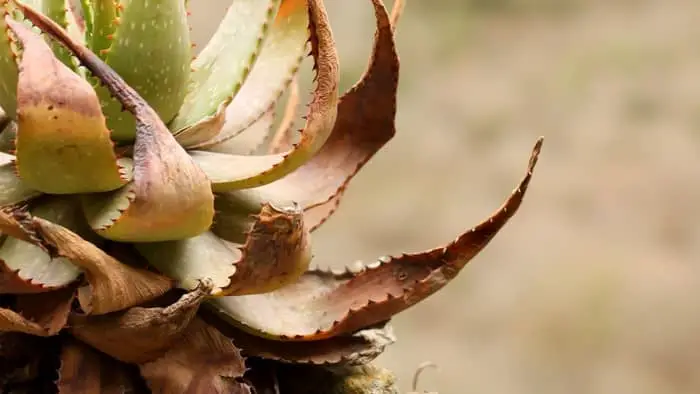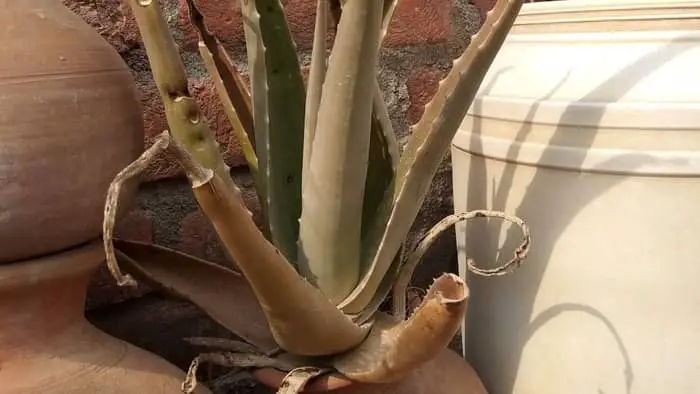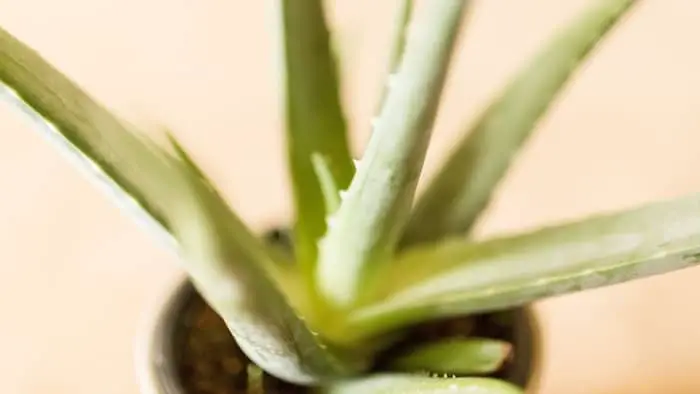Last Updated on March 21, 2022 by Mary Junriza C.
Is your aloe vera plant turning brown and soft? If your aloe vera leaves are starting to show signs of drying, you must quickly find out the source of the problem. Identifying what the issue is in the shortest time possible may save your plant.
Aloe vera plants are not hard to care for. In fact, they can grow in neglect. But when your aloe vera plant starts yellowing or browning, it requires immediate attention to survive. There are many reasons why your aloe is turning brown such as overwatering, underwatering, excessive heat, drafts or cold air, sunburn, too much fertilizer, pests, or diseases.
Signs Of A Dying Aloe Plant
Note that some yellowing is natural. Old aloe vera leaves can dry and wither after some time. But this is soon replaced with young leaves, which are greener, more upright, and firm. You know it’s natural when the yellowing starts from the bottom of your plants. The following are signs of an unhealthy aloe plant.
Spotted Leaves
Brown or black spots forming on the leaves are signs of fungal infection called aloe rust. These dark spots can gradually eat away the leaves of your plant. This kind of infection usually happens when the plant doesn’t receive adequate sunlight.
Mushy, Dark Lower Leaves
If the stems of your aloe vera are somewhat mushy, it is caused y overwatering. To resolve this problem, remove the aloe from the current pot and discard the soil. Prepare a well-draining succulent mix by combining garden soil, sand, and pumice.
Drooping Leaves
Ideally, aloe vera should have upright, thick leaves. Root rot and waterlogging can sometimes cause leaves to become heavier. To remedy this situation, use sterilized sheers to cut sagging leaves. Depending on how far back, you may need to cut until the bottom.
Tip Dieback
Tip Dieback is a common issue for aloe vera with poor-draining soil. It begins with the drying and browning of the tip until it goes to the bottom. Once it reaches the bottom, your plant can entirely turn brown and shrivel. Before anything worse could happen, prune your aloe vera plant and let go of the dried tips.
Salvaging What’s Left With Your Aloe Plant
Depending on the issue, you can still salvage your aloe vera plan except for the part that has completely turned brown. If the stalk has completely turned brown, it means it’s died completely. The following are some tips on how to deal with your browning aloe vera.
- Prune your aloe vera. The best thing you can do is cut the affected leaf and rescue whatever is left. If only one leaf has become brown then you’re lucky. If the whole plant has dried and turned brown, uproot it and check the roots. If you see a rhizome, it is possible that you can still salvage it. Cut all the affected leaves and repot the rhizome. With proper care, it can grow leaves soon.
- Expose your aloe vera to indirect sunlight. An aloe plant that is slowly softening is a sign of overwatering. The aloe vera leaf contains soft translucent gel making it thick. If you remove a leaf and peel, it off, you can use extract the gel naturally and apply it to your hair. If your aloe plant is turning brown, expose your plant under indirect sunlight. This helps dry the excess water and normalize the soil. Aloe vera requires dry soil to thrive successfully.
- Pause watering for a bit. If you are guilty of overwatering your aloe vera, you have to let it rest for a while and let the soil dry naturally. It will prevent root rot and leaf-yellowing from going further.
- Re-asses the type of soil you are using. The perfect soil for aloe vera is a combination of gardening mix and pumice. Pumice improves the draining ability of the soil. If you have used loam, it means that your soil has been retaining more liquid than it should, which is why the leaves of your aloe vera are starting to get mushy. What you should do is replace the soil with a succulent mix. Succulent soil can be purchased from local nurseries or you can buy it online.
Conclusion: Preventing Your Plant From Dying
The best way to prevent future issues and diseases for any succulent – not just aloe vera – is to keep it as happy and healthy as possible. Follow proper care requirements for the plant. Make sure it is stable and put it in the preferred environment. Water regularly and expose it to the sun.
Here’s good news. Not all aloe plants that are turning brown are dying. Matured plants can have withered leave as it produces new ones. When aloe plants are growing, the leaves at the bottom start to become brown. Simply pull off the brown leaves to give your plant more room for growing.
FAQs
[rank_math_rich_snippet id=”s-723a4f3e-a683-4238-97f0-a09d6ffbbf2f”]



Leave a Reply
You must be logged in to post a comment.